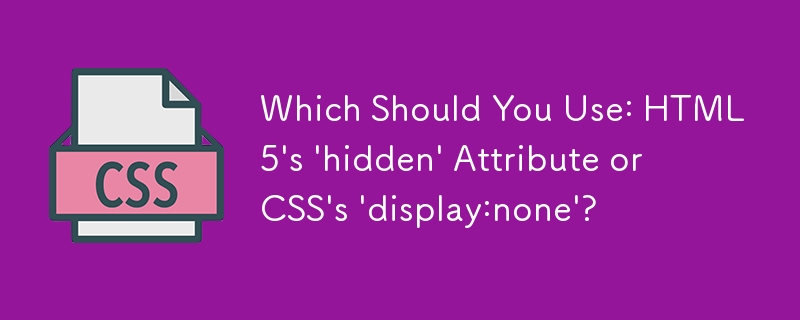 Web Front-end
Web Front-end
 CSS Tutorial
CSS Tutorial
 Which Should You Use: HTML5's 'hidden' Attribute or CSS's 'display:none'?
Which Should You Use: HTML5's 'hidden' Attribute or CSS's 'display:none'?
Which Should You Use: HTML5's 'hidden' Attribute or CSS's 'display:none'?

Understanding the Difference between HTML5's 'hidden' Attribute and CSS's 'display:none' Rule
In the realm of web development, we often encounter situations where we need to hide content from the user's view. Both HTML5 and CSS offer mechanisms to achieve this, namely the 'hidden' attribute and the 'display:none' rule respectively.
Key Distinction: Semantics vs. Presentation
While both approaches produce the same visual effect, they differ semantically. The 'hidden' attribute explicitly marks an element as hidden, regardless of the presentation context. On the other hand, the 'display:none' rule merely removes the element from the visual flow, leaving it accessible to screen readers or other assistive technologies.
Accessibility Considerations
The use of the 'display:none' rule alone can lead to accessibility issues, as screen readers and other technologies may still attempt to interact with the hidden content. In contrast, the 'hidden' attribute provides a clear semantic indication that the element should be ignored in all presentation contexts, ensuring optimal accessibility.
Guidelines for Use
When choosing between the two options, consider the following guidelines:
- Use 'hidden' when the content is not relevant for all presentations: This includes content that should be hidden from all users, such as sensitive information or commentary.
- Use 'display:none' when the content may be relevant in specific contexts: For example, when hiding menu items that are not currently visible due to a toggle button.
- Consider using a combination of 'hidden' and aria-*: This approach provides both a semantic indication of hidden content to web browsers and additional accessibility information for screen readers.
By carefully evaluating the semantic implications and accessibility impact, you can effectively hide content using either the 'hidden' attribute or the 'display:none' rule, ensuring a user-friendly and accessible experience for all visitors.
The above is the detailed content of Which Should You Use: HTML5's 'hidden' Attribute or CSS's 'display:none'?. For more information, please follow other related articles on the PHP Chinese website!

Hot AI Tools

Undresser.AI Undress
AI-powered app for creating realistic nude photos

AI Clothes Remover
Online AI tool for removing clothes from photos.

Undress AI Tool
Undress images for free

Clothoff.io
AI clothes remover

Video Face Swap
Swap faces in any video effortlessly with our completely free AI face swap tool!

Hot Article

Hot Tools

Notepad++7.3.1
Easy-to-use and free code editor

SublimeText3 Chinese version
Chinese version, very easy to use

Zend Studio 13.0.1
Powerful PHP integrated development environment

Dreamweaver CS6
Visual web development tools

SublimeText3 Mac version
God-level code editing software (SublimeText3)

Hot Topics
 Vue 3
Apr 02, 2025 pm 06:32 PM
Vue 3
Apr 02, 2025 pm 06:32 PM
It's out! Congrats to the Vue team for getting it done, I know it was a massive effort and a long time coming. All new docs, as well.
 A bit on ci/cd
Apr 02, 2025 pm 06:21 PM
A bit on ci/cd
Apr 02, 2025 pm 06:21 PM
I'd say "website" fits better than "mobile app" but I like this framing from Max Lynch:
 Can you get valid CSS property values from the browser?
Apr 02, 2025 pm 06:17 PM
Can you get valid CSS property values from the browser?
Apr 02, 2025 pm 06:17 PM
I had someone write in with this very legit question. Lea just blogged about how you can get valid CSS properties themselves from the browser. That's like this.
 Stacked Cards with Sticky Positioning and a Dash of Sass
Apr 03, 2025 am 10:30 AM
Stacked Cards with Sticky Positioning and a Dash of Sass
Apr 03, 2025 am 10:30 AM
The other day, I spotted this particularly lovely bit from Corey Ginnivan’s website where a collection of cards stack on top of one another as you scroll.
 Using Markdown and Localization in the WordPress Block Editor
Apr 02, 2025 am 04:27 AM
Using Markdown and Localization in the WordPress Block Editor
Apr 02, 2025 am 04:27 AM
If we need to show documentation to the user directly in the WordPress editor, what is the best way to do it?
 Comparing Browsers for Responsive Design
Apr 02, 2025 pm 06:25 PM
Comparing Browsers for Responsive Design
Apr 02, 2025 pm 06:25 PM
There are a number of these desktop apps where the goal is showing your site at different dimensions all at the same time. So you can, for example, be writing
 How to Use CSS Grid for Sticky Headers and Footers
Apr 02, 2025 pm 06:29 PM
How to Use CSS Grid for Sticky Headers and Footers
Apr 02, 2025 pm 06:29 PM
CSS Grid is a collection of properties designed to make layout easier than it’s ever been. Like anything, there's a bit of a learning curve, but Grid is
 Why are the purple slashed areas in the Flex layout mistakenly considered 'overflow space'?
Apr 05, 2025 pm 05:51 PM
Why are the purple slashed areas in the Flex layout mistakenly considered 'overflow space'?
Apr 05, 2025 pm 05:51 PM
Questions about purple slash areas in Flex layouts When using Flex layouts, you may encounter some confusing phenomena, such as in the developer tools (d...





